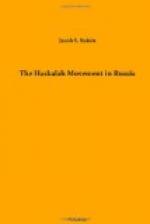“We have seen our youths return to us,” writes Lilienblum,[14] “and our hearts were filled with joy. In their restoration we found balm for our wounds, and with rapturous wonderment we asked ’who has borne us these?’” The poets welcomed them with songs. Gordon, whose sorrow had silenced his muse, was inspired once more and called:
Behold our sons, of whom we despaired,
Return to us, the great and the small;
God’s grace is not ended, our power’s
unimpaired,
Again we shall live, and rise after the
fall!
Frug sang in Russian:
My
own Nation,
Thou art not alone; thy sons behold
Coming back in crowds as in days of old!
And Zunser represented Rachel as soliloquizing in Yiddish:
Through the windows what am I seeing,
Like turtle-doves hitherward fleeing?
Are my Joseph and Benjamin knocking at
my door?
O Heavens, O mighty wonder!
Those are my children yonder!
Yes, my dearest and my truest coming home
once more!
But Zionism is not exclusively either a political or a religious movement. It is both plus something else; it is eminently educational. It has produced novelists and poets, whose writings are full of the virility and beauty of a rejuvenated nation. In Jaffa it established a high school (Bet ha-Sefer), it inspired Doctor Chazanowicz to establish a national library, and ways and means are being considered to establish a national university in Palestine.
Even among the devotees of the arts it has given rise to a new romantic school, young painters and sculptors who are depicting their Judenschmerz.
Their cunning hands—says Mr. Leo Mielziner—have mastered the technique of their art, be it in Moscow or Munich, or Berlin, or Paris, but the heart which inspires their brush or mallet pulsates in Palestine. The wandering Jew in them pauses, not to portray the impression of the foreign lands and stranger customs, but to depict his own suffering, his own Heimweh, his own aspirations.
Struck, Ashkenasi, Maimon, Hirszenberg, Gottlieb, Epstein, Loebschuetz, and Schatz are the leaders of this new movement. The last-named, together with Ephraim Moses Lilien of Galicia, perhaps the greatest Jewish illustrator of our time, has founded a national school, Bezalel, to propagate Jewish art in Palestine, on the same principles on which the great national art schools of other countries are based. The language of instruction is Hebrew.
Meanwhile the Society for the Promotion of Haskalah continued its work of Russification and general civilization. After 1880 its activity was greatly enhanced, and its members worked with renewed zeal. It opened elementary schools, and expended large sums on stipends for students, and the publication of useful and scholarly books. The branch in Odessa secured two hundred and thirty-one new members in one year (1900), making the total in that city alone nine hundred and sixty-eight. It organized a bureau of information on pedagogic subjects, and through the liberality of Kalonymos Wissotzky instituted prizes for original works in Hebrew or Russian. Individual philanthropists did their utmost to counterbalance the restrictions on education.[15]




